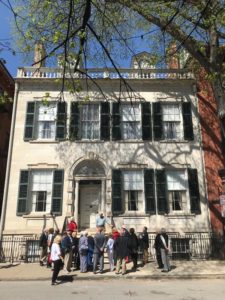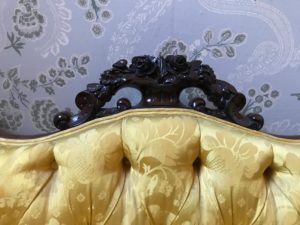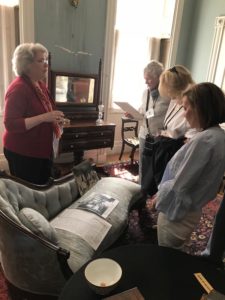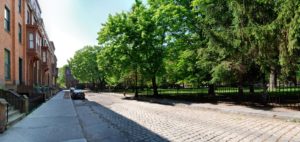Community Efforts Rebuild Troy’s Legacy
EVENTS > SYMPOSIA
In Review: The Decorative Arts Trust Spring Symposium, 2018
Over the course of our spring 2018 symposium to the Upper Hudson, the city of Troy emerged as a surprise favorite among participants. Long dismissed as a post-industrial backwater, the city has enjoyed a renaissance in the past decade as an active university town, with a thriving appreciation of historic preservation. Whether attendees were admiring the original furnishings at the Rensselaer County Historical Society’s Hart-Cluett House, exploring the intact Tiffany interiors at St. Paul’s Church, or strolling along the picturesque sidewalks of Washington Square Park, they were reminded of city’s noteworthy heritage.
Chartered in 1816, Troy quickly became one of the wealthiest cities in the country, thanks to its strategic location at the juncture of the Hudson River and Erie Canal and ready access to fuel and iron ore, creating an industrial center only surpassed by Pittsburgh. The city’s prosperous families built splendid townhouses downtown. Starting in 1840, the well-heeled neighborhoods expanded a few blocks south into the Washington Park district, modeled after New York City’s Gramercy Park. Reflecting their close business and social ties with that city, Troy residents hired New York-based architects and imported fine luxury goods from the city’s merchants and craftsmen. A demand for locally made high-quality furnishings, however, was large enough to support the talented cabinetmaker Elijah Galusha. Many of his impressive Rococo Revival wares are still found at the Hart-Cluett House, along with the original bills of sale from the family archives.
Troy’s prosperity increased as the 19th century progressed, and the city became home for business tycoons, politicians, and diplomats, resulting in several fine public buildings, chief among them St. Paul’s Episcopal Church, a stunning hybrid of Gothic and Aesthetic Movement elements that captivated Trust members. The church is one of only four intact interiors by Tiffany Glass and Decorating Company.
The Great Depression sent Troy into decline. The loss of manufacturing jobs decimated lower-wage income, while the popularity of the automobile and changing tastes led wealthier residents to move to suburbs and estates east of the city. While some buildings, such as the Hart-Cluett House, quickly transitioned to new roles as museums or civic centers, the majority of the once-grand townhouses were subdivided into apartments or simply left vacant. Beginning in the 1960s and 70s, local architects and history aficionados led the fight to preserve the city’s architectural heritage, successfully leading campaigns to add St. Paul’s and the Troy Savings Bank Music Hall to the National Register of Historic Places. Despite these successes, large portions of the city continued to deteriorate.
Of particular concern was the Washington Park neighborhood. By 1994, several houses around the private park were vacant, including six of the ten original 1840 row houses on Washington Place, the park’s southern boundary. In 2000, decades of accumulated water damage in the long-vacant townhouse at 8 Washington Place sent the roof and the three stories below crashing into the cellar, thereby threatening the structural stability of the two adjacent properties.
Instead of accepting almost inevitable demolition, the Washington Park Association, a consortium of local property owners who oversee the care of the park, sprang into action. Led by Association President Lynn Kopka, the group emerged as a force to be reckoned with. Lynn worked with the New York State Office of Parks, Recreation and Historic Preservation, as well as local architecture and engineering firms, to obtain a $70,000 matching grant to stabilize the townhouse, a complex process that involved bringing a backhoe into the cellar to clear out debris, and reinstalling every third floor joist. Years of hard work and community effort finally paid off in 2011, when brothers Victor and Jon Sosnowski purchased the building and completed the renovation. Other new owners have stepped forward, carefully restoring most of the houses around the square.
Local real estate developer Michael Flynn recently purchased a townhouse on 2nd Street, the Park’s eastern side, and is creating apartments that will be sensitive to the original interiors. He has known the Washington Park community for 30 years, and has many friends who live there. “I was drawn to the historical value of the property,” he explains, “and the uniqueness of having a privately-owned park across the street, which is one of only two in the state. I look forward to bringing more residents to this special place, which will in turn enhance property values.” The benefits are not limited to historic preservation or investment return, however. The Washington Park Association’s efforts have turned the neighborhood into a tight-knit urban community. “It’s a wonderful place to live,” says Ms. Kopka, “and it’s great to have people wanting to be here again.”







